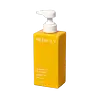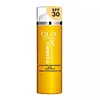What's inside
What's inside
 Key Ingredients
Key Ingredients

 Benefits
Benefits

 Concerns
Concerns

 Ingredients Side-by-side
Ingredients Side-by-side

Water
Skin ConditioningCetyl Alcohol
EmollientGlycerin
HumectantDimethicone
EmollientButyrospermum Parkii Butter
Skin ConditioningCeteareth-20
CleansingTetrahexyldecyl Ascorbate
AntioxidantAscorbic Acid
AntioxidantCurcuma Longa Root Extract
MaskingFerulic Acid
AntimicrobialTerminalia Ferdinandiana Fruit Extract
AntioxidantPyrus Malus Fruit Extract
Skin ConditioningZingiber Officinale Root Extract
MaskingAloe Barbadensis Leaf Juice
Skin ConditioningPanax Ginseng Root Extract
EmollientTocopheryl Acetate
AntioxidantHelianthus Annuus Extract
EmollientOryza Sativa Bran Extract
Skin ConditioningRosmarinus Officinalis Leaf Extract
AntimicrobialTocopherol
AntioxidantCetearyl Ethylhexanoate
EmollientIsopropyl Myristate
EmollientCetearyl Phosphate
Skin ConditioningGlyceryl Stearate
EmollientSynthetic Beeswax
Emulsion StabilisingCarbomer
Emulsion StabilisingXanthan Gum
EmulsifyingTetrasodium Glutamate Diacetate
Parfum
MaskingPhenoxyethanol
PreservativeEthylhexylglycerin
Skin ConditioningCaprylyl Glycol
EmollientHexylene Glycol
EmulsifyingSodium Hydroxide
BufferingLimonene
PerfumingLinalool
PerfumingWater, Cetyl Alcohol, Glycerin, Dimethicone, Butyrospermum Parkii Butter, Ceteareth-20, Tetrahexyldecyl Ascorbate, Ascorbic Acid, Curcuma Longa Root Extract, Ferulic Acid, Terminalia Ferdinandiana Fruit Extract, Pyrus Malus Fruit Extract, Zingiber Officinale Root Extract, Aloe Barbadensis Leaf Juice, Panax Ginseng Root Extract, Tocopheryl Acetate, Helianthus Annuus Extract, Oryza Sativa Bran Extract, Rosmarinus Officinalis Leaf Extract, Tocopherol, Cetearyl Ethylhexanoate, Isopropyl Myristate, Cetearyl Phosphate, Glyceryl Stearate, Synthetic Beeswax, Carbomer, Xanthan Gum, Tetrasodium Glutamate Diacetate, Parfum, Phenoxyethanol, Ethylhexylglycerin, Caprylyl Glycol, Hexylene Glycol, Sodium Hydroxide, Limonene, Linalool
Butyl Methoxydibenzoylmethane 3%
UV AbsorberHomosalate 9%
Skin ConditioningEthylhexyl Salicylate 4.5%
UV AbsorberOctocrylene 6%
UV AbsorberWater
Skin ConditioningGlycerin
HumectantZea Mays Starch
AbsorbentNiacinamide
Smoothing3-O-Ethyl Ascorbic Acid
Skin ConditioningPalmitoyl Pentapeptide-4
Skin ConditioningPanthenol
Skin ConditioningDimethicone
EmollientCaprylyl Glycol
EmollientDimethiconol
EmollientCetearyl Glucoside
EmulsifyingCetearyl Alcohol
EmollientStearic Acid
CleansingPalmitic Acid
EmollientStearyl Alcohol
EmollientCetyl Alcohol
EmollientBehenyl Alcohol
EmollientDisodium EDTA
Hydroxyethyl Acrylate/Sodium Acryloyldimethyl Taurate Copolymer
Emulsion StabilisingPEG-100 Stearate
1,2-Hexanediol
Skin ConditioningPhenoxyethanol
PreservativeParfum
MaskingAscorbic Acid
AntioxidantAvena Sativa Peptide
Skin ConditioningButyl Methoxydibenzoylmethane 3%, Homosalate 9%, Ethylhexyl Salicylate 4.5%, Octocrylene 6%, Water, Glycerin, Zea Mays Starch, Niacinamide, 3-O-Ethyl Ascorbic Acid, Palmitoyl Pentapeptide-4, Panthenol, Dimethicone, Caprylyl Glycol, Dimethiconol, Cetearyl Glucoside, Cetearyl Alcohol, Stearic Acid, Palmitic Acid, Stearyl Alcohol, Cetyl Alcohol, Behenyl Alcohol, Disodium EDTA, Hydroxyethyl Acrylate/Sodium Acryloyldimethyl Taurate Copolymer, PEG-100 Stearate, 1,2-Hexanediol, Phenoxyethanol, Parfum, Ascorbic Acid, Avena Sativa Peptide
Ingredients Explained
These ingredients are found in both products.
Ingredients higher up in an ingredient list are typically present in a larger amount.
Ascorbic Acid is is pure Vitamin C. This form makes up the largest amount of vitamin C found naturally in our skin.
Not only is vitamin C great for your overall health and immune system, it also has plenty of benefits on your skin.
Vitamin C is best used for brightening skin. It improves dark spots, acne scars, and hyperpigmentation. This is because it blocks the process of skin darkening when exposed to UV.
Remember: Vitamin C should not replace sunscreen!
Your skin uses vitamin C to build collagen. Collagen is one key component in having a strong skin barrier and plump skin. Vitamin C also plays a role in regulating collagen, thus making it effective in improving wrinkles and fine lines.
Ascorbic acid shows potent antioxidant activity. As an antioxidant, it helps fight free-radicals. Free-radicals are molecules that may damage your skin cells. These antioxidants also protect skin against UV damage.
The best formulations include Vitamin E and/or ferulic acid. These two ingredients help stabilize and provide a boost in the benefits of ascorbic acid. This is because ascorbic acid becomes unstable when exposed to UV and air. In fact, you can tell your ascorbic acid has oxidized when it turns an orange-yellow color.
Ascorbic acid is generally compatible with other ingredients. However, using ascorbic acid with other active ingredients might cause irritation. Two ingredients: copper ions and benzoyl peroxide, will inactivate ascorbic acid completely.
Read more about other types of Vitamin C:
Foods rich with vitamin C include oranges, strawberries, broccoli, bell peppers, and more. When consuming Vitamin C, your skin receives a portion of the nutrients.
Learn more about Ascorbic AcidCaprylyl Glycol is a humectant and emollient, meaning it attracts and preserves moisture.
It is a common ingredient in many products, especially those designed to hydrate skin. The primary benefits are retaining moisture, skin softening, and promoting a healthy skin barrier.
Though Caprylyl Glycol is an alcohol derived from fatty acids, it is not the kind that can dry out skin.
This ingredient is also used as a preservative to extend the life of products. It has slight antimicrobial properties.
Learn more about Caprylyl GlycolCetyl Alcohol is a fatty alcohol. Fatty Alcohols are most often used as an emollient or to thicken a product.
Its main roles are:
Though it has "alcohol" in the name, it is not related to denatured alcohol or ethyl alcohol.
The FDA allows products labeled "alcohol-free" to have fatty alcohols.
Learn more about Cetyl AlcoholDimethicone is a type of synthetic silicone created from natural materials such as quartz.
What it does:
Dimethicone comes in different viscosities:
Depending on the viscosity, dimethicone has different properties.
Ingredients lists don't always show which type is used, so we recommend reaching out to the brand if you have questions about the viscosity.
This ingredient is unlikely to cause irritation because it does not get absorbed into skin. However, people with silicone allergies should be careful about using this ingredient.
Note: Dimethicone may contribute to pilling. This is because it is not oil or water soluble, so pilling may occur when layered with products. When mixed with heavy oils in a formula, the outcome is also quite greasy.
Learn more about DimethiconeGlycerin is already naturally found in your skin. It helps moisturize and protect your skin.
A study from 2016 found glycerin to be more effective as a humectant than AHAs and hyaluronic acid.
As a humectant, it helps the skin stay hydrated by pulling moisture to your skin. The low molecular weight of glycerin allows it to pull moisture into the deeper layers of your skin.
Hydrated skin improves your skin barrier; Your skin barrier helps protect against irritants and bacteria.
Glycerin has also been found to have antimicrobial and antiviral properties. Due to these properties, glycerin is often used in wound and burn treatments.
In cosmetics, glycerin is usually derived from plants such as soybean or palm. However, it can also be sourced from animals, such as tallow or animal fat.
This ingredient is organic, colorless, odorless, and non-toxic.
Glycerin is the name for this ingredient in American English. British English uses Glycerol/Glycerine.
Learn more about GlycerinParfum is a catch-all term for an ingredient or more that is used to give a scent to products.
Also called "fragrance", this ingredient can be a blend of hundreds of chemicals or plant oils. This means every product with "fragrance" or "parfum" in the ingredients list is a different mixture.
For instance, Habanolide is a proprietary trade name for a specific aroma chemical. When used as a fragrance ingredient in cosmetics, most aroma chemicals fall under the broad labeling category of “FRAGRANCE” or “PARFUM” according to EU and US regulations.
The term 'parfum' or 'fragrance' is not regulated in many countries. In many cases, it is up to the brand to define this term.
For instance, many brands choose to label themselves as "fragrance-free" because they are not using synthetic fragrances. However, their products may still contain ingredients such as essential oils that are considered a fragrance by INCI standards.
One example is Calendula flower extract. Calendula is an essential oil that still imparts a scent or 'fragrance'.
Depending on the blend, the ingredients in the mixture can cause allergies and sensitivities on the skin. Some ingredients that are known EU allergens include linalool and citronellol.
Parfum can also be used to mask or cover an unpleasant scent.
The bottom line is: not all fragrances/parfum/ingredients are created equally. If you are worried about fragrances, we recommend taking a closer look at an ingredient. And of course, we always recommend speaking with a professional.
Learn more about ParfumPhenoxyethanol is a preservative that has germicide, antimicrobial, and aromatic properties. Studies show that phenoxyethanol can prevent microbial growth. By itself, it has a scent that is similar to that of a rose.
It's often used in formulations along with Caprylyl Glycol to preserve the shelf life of products.
Water. It's the most common cosmetic ingredient of all. You'll usually see it at the top of ingredient lists, meaning that it makes up the largest part of the product.
So why is it so popular? Water most often acts as a solvent - this means that it helps dissolve other ingredients into the formulation.
You'll also recognize water as that liquid we all need to stay alive. If you see this, drink a glass of water. Stay hydrated!
Learn more about Water